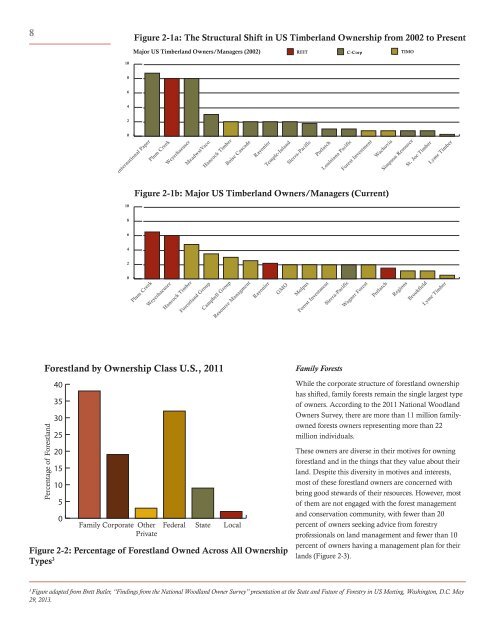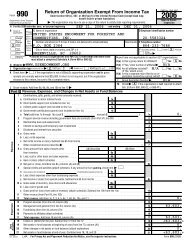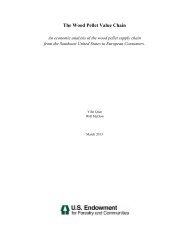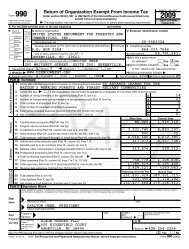8Figure 2-1a: <strong>The</strong> Structural Shift in US Timberl<strong>and</strong> Ownership from 2002 to PresentMajor US Timberl<strong>and</strong> Owners/Managers (2002)REIT C-Corp TIMO1086420International PaperPlum CreekWeyerhaeuserMeadwstVacoHancock TimberBoise CascadeRayonierTemple-Inl<strong>and</strong>Sierra-PacificPotlatchLouisiana Pacific<strong>Forest</strong> InvestmentWachoviaSimpson ResourceSt. Joe TimberLyme TimberFigure 2-1b: Major US Timberl<strong>and</strong> Owners/Managers (Current)1086420Plum CreekWeyerhaeuserHancock Timber<strong>Forest</strong>l<strong>and</strong> GroupCampbell GroupResource ManagmentRayonierGMOMolpus<strong>Forest</strong> InvestmentSierra-PacificWagner <strong>Forest</strong>PotlatchRegionsBrookfieldLyme Timber<strong>Forest</strong>l<strong>and</strong> by Ownership Class U.S., 2011Percentage <strong>of</strong> <strong>Forest</strong>l<strong>and</strong>4035302520151050Family Corporate O<strong>the</strong>r Federal <strong>State</strong> LocalPrivateFigure 2-2: Percentage <strong>of</strong> <strong>Forest</strong>l<strong>and</strong> Owned Across All OwnershipTypes 3Family <strong>Forest</strong>sWhile <strong>the</strong> corporate structure <strong>of</strong> forestl<strong>and</strong> ownershiphas shifted, family forests remain <strong>the</strong> single largest type<strong>of</strong> owners. According to <strong>the</strong> 2011 National Woodl<strong>and</strong>Owners Survey, <strong>the</strong>re are more than 11 million familyownedforests owners representing more than 22million individuals.<strong>The</strong>se owners are diverse in <strong>the</strong>ir motives for owningforestl<strong>and</strong> <strong>and</strong> in <strong>the</strong> things that <strong>the</strong>y value about <strong>the</strong>irl<strong>and</strong>. Despite this diversity in motives <strong>and</strong> interests,most <strong>of</strong> <strong>the</strong>se forestl<strong>and</strong> owners are concerned withbeing good stewards <strong>of</strong> <strong>the</strong>ir resources. However, most<strong>of</strong> <strong>the</strong>m are not engaged with <strong>the</strong> forest management<strong>and</strong> conservation community, with fewer than 20percent <strong>of</strong> owners seeking advice from forestrypr<strong>of</strong>essionals on l<strong>and</strong> management <strong>and</strong> fewer than 10percent <strong>of</strong> owners having a management plan for <strong>the</strong>irl<strong>and</strong>s (Figure 2-3).3Figure adapted from Brett Butler, “Findings from <strong>the</strong> National Woodl<strong>and</strong> Owner Survey” presentation at <strong>the</strong> <strong>State</strong> <strong>and</strong> <strong>Future</strong> <strong>of</strong> <strong><strong>Forest</strong>ry</strong> in US Meeting, Washington, D.C. <strong>May</strong>29, 2013.
Summary—Priority Issues <strong>of</strong> ConcernAmidst <strong>the</strong> backdrop <strong>of</strong> a changing l<strong>and</strong>scape <strong>of</strong>forestl<strong>and</strong> ownership <strong>and</strong> <strong>the</strong> access to timber <strong>and</strong>biomass to supply forest products markets, <strong>the</strong>reare three priority issues <strong>of</strong> concern: Developingrobust forest communities, improving l<strong>and</strong>ownerengagement, <strong>and</strong> keeping forests as forests.AdviceManagementPlansTraditional Engagement ActivitiesOwnership & Acres, U.S., 2011AcresOwnership9Measures <strong>of</strong> SuccessCost-share<strong>The</strong> measures <strong>of</strong> success regarding developingrobust forest communities, improving l<strong>and</strong>ownerengagement, <strong>and</strong> keeping forests as forests should beachievable in concert with one ano<strong>the</strong>r. This chapterfocuses on <strong>the</strong> role <strong>of</strong> private forestl<strong>and</strong>s in <strong>the</strong>supply <strong>of</strong> wood products <strong>and</strong> in <strong>the</strong> continuation <strong>of</strong>maintaining a forested l<strong>and</strong>scape <strong>and</strong> all <strong>of</strong> its inherentenvironmental <strong>and</strong> societal benefits. Successfulmeasures will necessarily be both reactive <strong>and</strong> proactive.Current threats must be addressed reactively. ForEasementsCertifications0 20 40 60 80 100Figure 2-3: Percentage <strong>of</strong> <strong>Forest</strong> ManagementActivities Pursued by Owners <strong>and</strong> Across Acres 4instance, <strong>the</strong> widespread declines in reliable supplies <strong>of</strong> raw materials must be reversed—<strong>the</strong>se declines are not dueto lack <strong>of</strong> raw materials, but due to l<strong>and</strong> ownership changes, access, <strong>and</strong> reductions to infrastructure <strong>and</strong> workforce.<strong>The</strong> rebuilding <strong>of</strong> communities <strong>and</strong> <strong>the</strong> te<strong>the</strong>ring toge<strong>the</strong>r <strong>of</strong> l<strong>and</strong>owners with access to resources <strong>and</strong> expertiseare more prospective. Existing programs, such as Tree Farm, group certifications, <strong>and</strong> l<strong>and</strong>owner associations,can document <strong>and</strong> grow <strong>the</strong> degree to which l<strong>and</strong>owners are increasing <strong>the</strong>ir use <strong>of</strong> pr<strong>of</strong>essional natural resourcesassistance <strong>and</strong> enrollment in programs intended to assist in good forest management. Yet, much more must bedone.Action Items—General<strong>The</strong> items enumerated below are intended to outline specific courses <strong>of</strong> action that are achievable <strong>and</strong> tied to atimeline. A general timeline suggests that initial efforts begin prior to January 2014. Any action item should allowsome flexibility in implementation, but each should also have enough specificity to make clear what is importantto be done. In addressing <strong>the</strong> concern <strong>of</strong> <strong>the</strong> loss <strong>of</strong> productive private forestl<strong>and</strong>, all desired action items shouldstrive towards maintaining (or increasing) forest cover <strong>and</strong> incentivizing <strong>the</strong> people <strong>and</strong> communities that caninfluence <strong>the</strong> future <strong>of</strong> <strong>the</strong>se l<strong>and</strong>s.Individuals should be identified at <strong>the</strong> state level to assume leadership in moving <strong>the</strong>se actions forward. In somecases, <strong>the</strong>se individuals may be in <strong>the</strong> best position to coordinate <strong>the</strong>se efforts <strong>the</strong>mselves; in o<strong>the</strong>r instances, <strong>the</strong>ymay identify o<strong>the</strong>r individuals in <strong>the</strong>ir states. Ideally, each state should develop a baseline against which statusreports are developed to indicate progress.Action Items—Specifics<strong>The</strong> following specific action items are intended to provide direction to one or more agencies/organizationswith <strong>the</strong> capacity to effect change regarding <strong>the</strong> previously listed priorities <strong>of</strong> concern. Each item below shouldbe considered as a component to be pursued in concert with o<strong>the</strong>r actions listed elsewhere in this document.Timelines <strong>and</strong> benchmarks are provided as rough guidelines. Staffing <strong>and</strong> funding will be challenges to initiate anynew action items, but low-cost options for labor exist in many forms, including service-learning programs throughspecific college <strong>and</strong> university courses as well as internships <strong>and</strong> practicums. Fur<strong>the</strong>r, grant monies can serve tostimulate progress <strong>and</strong> build out portions <strong>of</strong> <strong>the</strong> recommendations in this document.4Figure adapted from Butler presentation.





